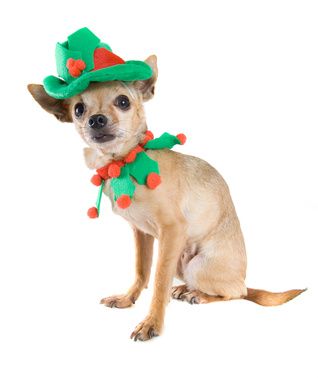Attention to the extras of holiday meals !
 What a pleasure to share with his animal the delights of the year-end festivities and to see to feast with us!
What a pleasure to share with his animal the delights of the year-end festivities and to see to feast with us!
But a pet is not a human being : his body doesn't work like ours and a totally harmless food for us may be toxic in our companions, even at small doses!
To avoid a visit to emergency vet in these times of celebrations, some dishes that may yet seem us totally harmless, will be carefully put out of reach of our animals.
Chocolate
 Chocolate is never present on our tables in these periods of holidays. Attention however of Although the keep out of reach of our friends the animals :
Chocolate is never present on our tables in these periods of holidays. Attention however of Although the keep out of reach of our friends the animals :
Indeed, It contains a substance called theobromine that has significant toxicity to pets. This substance is present in varying quantities in various kinds of chocolates: It is about three times more present in dark chocolate than milk chocolate and is almost absent in white chocolate
Toxic doses are reported to be between 100 and 300 mg of theobromine absorbed per kilogram (either a dose of 150 to 300 grams of dark chocolate about for a dog to 10 Kg) but they seem to highly variable from one individual to another.
The symptoms of poisoning appear in the 2 to 4 hours following ingestion of chocolate:
– Of digestive signs are noted with vomiting, a possible salivation and diarrhea of dark. These digestive signs are accompanied by an abnormal agitation of the animal.
– After a few hours, from serious cardiac disorders appear: the heart rate increases (tachycardia), hypertension and rhythm disorders may occur.
These anomalies can be added with nervous disorders : The animal seems hyperaggressive, It presents an abnormal gait (with an incoordination of movements) and can get up to convulse, and even falling into coma.
The prognosis chocolate poisoning is reserved because there is no antidote capable of eliminating the theobromine of the body of the animal.
If you suspect this poisoning in your pet, You should go to your vet as soon as possible : It will implement a symptomatic treatment.
The speed of implementation of the treatment improves prognosis. Therefore, do not expect the first symptoms before contacting your veterinarian.
The toxicity chocolate can be acute (a dog who has stolen and absorbed chocolate wafers can present serious heart rhythm disorders and die in the 18 to 24 hours following the occurrence of these problems) but also cumulative (regular intake of small quantities of chocolate distributed by owners may be accompanied by the appearance of cardiac disorders). All administration of chocolate is therefore absolutely inappropriate your animal.
Salty food
 The abuse of salt can be harmful to your pet. En holiday season, It will be found essentially in the fish such as salmon or smoked trout, the Deli meats (raw ham, Bacon), the peanuts…
The abuse of salt can be harmful to your pet. En holiday season, It will be found essentially in the fish such as salmon or smoked trout, the Deli meats (raw ham, Bacon), the peanuts…
Although low toxicity, the dangerousness of the salt is due primarily to the fact that the salty foods are extremely constituents for all animal species and therefore likely to be ingested in very large quantities.
Toxic doses ranging from a few grams of salt swallowed a few tens of grams (Depending on the weight of the animal) carnivores and rodents.
Ingestion in large quantities of foodstuffs mentioned previously will cause a significant dehydration of the animal and the appearance of various disorders in a few minutes to a few hours:
– Of digestive signs with vomiting and significant diarrhea and intense thirst.
– Of neurological signs : the animal may present significant agitation, gait disorders, a sudden loss of vision, convulsions and even loss of consciousness or coma in the most serious cases.
The prognosis Salt poisoning is good when only digestive signs are present but becomes Dark in the case of neurological disorders.
During intoxication with salt, It is important to drink the animal if he can then consult your vet so it can treat dehydration and possible neurological symptoms.
Coffee
Chocolate Yule log, coffee ganache, small cafe that accompanies the holiday desserts… all these sweets should not be proposed to our companions.
Caffeine contained in this coffee a toxicity in our domestic carnivores.
The time to onset of symptoms varies between one and twelve hours after ingestion.
The symptoms observed in poisoning by caffeine are close enough
those observed in the chocolate poisoning :
– Of Cardiac disorders with onset of tachycardia
– Of neurological disorders with seizures
– One possible cardio-respiratory arrest responsible for the death of the animal.
As for the chocolate poisoning, The prognosis of coffee poisoning is reserved
and is greatly enhanced by the earliness of the intervention of a veterinarian who can put in place a symptomatic treatment of cardiac and neurological disorders that may accompany this type of poisoning.
Macadamia nuts
During the holidays, baskets of dried fruits and nuts are very frequently present on our tables. These fruits including nuts, hazelnuts are prohibited in our animals and especially the nut of macadamia in issue in a large number of poisonings.
THEhead element The macadamia nut poisoning is still unknown so far .
Clinical signs can appear following ingestion of a few grams a few tens of grams of macadamia nuts depending on the weight of the animal.
These symptoms are the appearance within six to twenty-four hours following
ingestion of nuts from locomotion disorders : animals generally refuse to move and often suffer from joint and muscle pain. They may also exhibit a State of weakness, depression, going to vomit or even to shake.
The prognosis This type of poisoning is very good : full recovery is usually obtained in 24 to 48 hours.
If ingestion of Macadamia nuts has been observed and is very recent, the veterinarian will be able to vomit the animal to remove a maximum of absorbed nuts.
In other cases, pain treatment will be administered during 48 hours to limit the aching joints and muscles of the dog.
Alcoholic beverages
 Think of never to allow access to the remains of liquor to your pets in the
Think of never to allow access to the remains of liquor to your pets in the
forgetting on a coffee table for example… The ingestion of these drinks can, Indeed, have serious consequences.
The toxic implicated in this type of poisoning is ethanol.
The latter will be rapidly absorbed after ingestion and will cause various symptoms. The disorders will appear so much faster that the animal will have an empty stomach (the appearance of symptoms will vary within an hour animal fasting for several hours in an animal whose stomach is full).
Clinical signs of poisoning usually appear within the next hour
ingestion of ethanol, when'BAC reaches about 1 to 1,5 g/L.
The animal will then change behavior, it may start to throw up then present nervous disorders responsible uncoordinated movements and up coma.
Death may occur following cardiac arrest or respiratory.
The prognosis is pretty good below a certain alcohol (3 g/L) if appropriate treatment is in place : the veterinarian will be able to place the animal under perfusion to fight against dehydration and help eliminate the toxic.
During severe intoxication the animal may be placed under oxygen to support its respiratory function.
Finally, some foods not present not one direct toxicity but can cause various annoyances :
This is particularly the case for Turkey or goose bones that could be attempting to distribute the dog after the meal. These can cause significant inflammation of the digestive tract and cause diarrhoea and vomiting.
In the same way, very greasy foods (fatty liver…) may promote the occurrence at our pets of some diseases such as pancreatitis.
§
Pets do not need to diversify their diet every day to be happy.
If you however want to make them a little pleasure in these times of celebrations, treats specially designed for them will be more adapted, this without the slightest danger to the health of your fellow.
